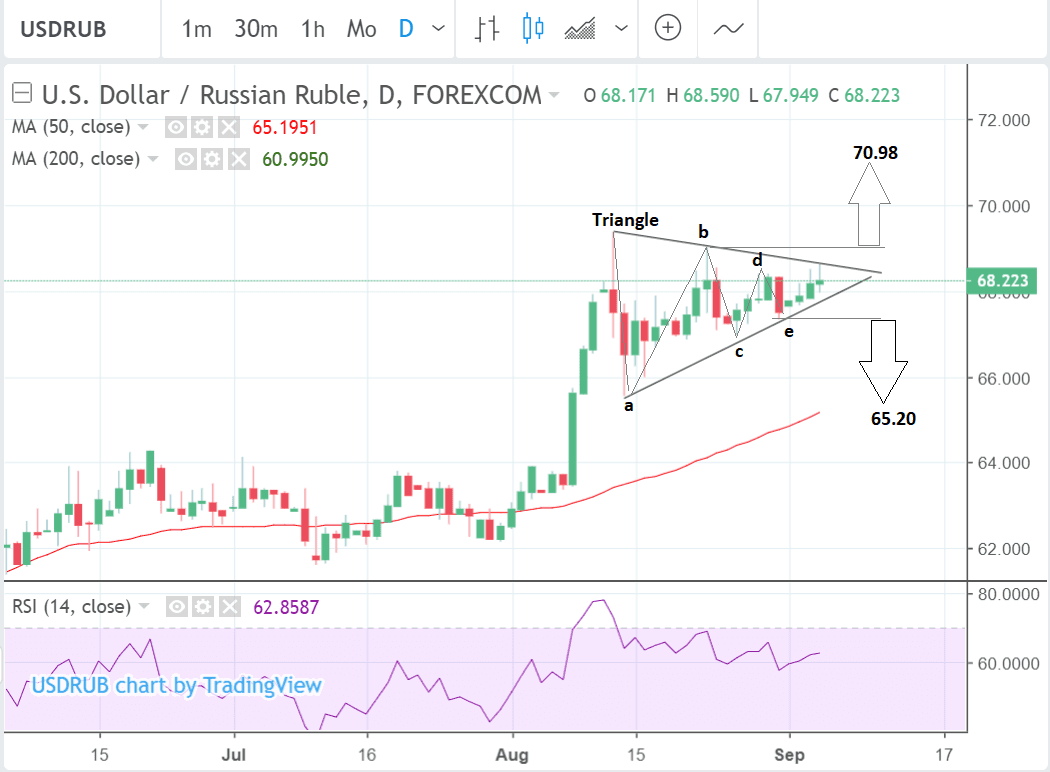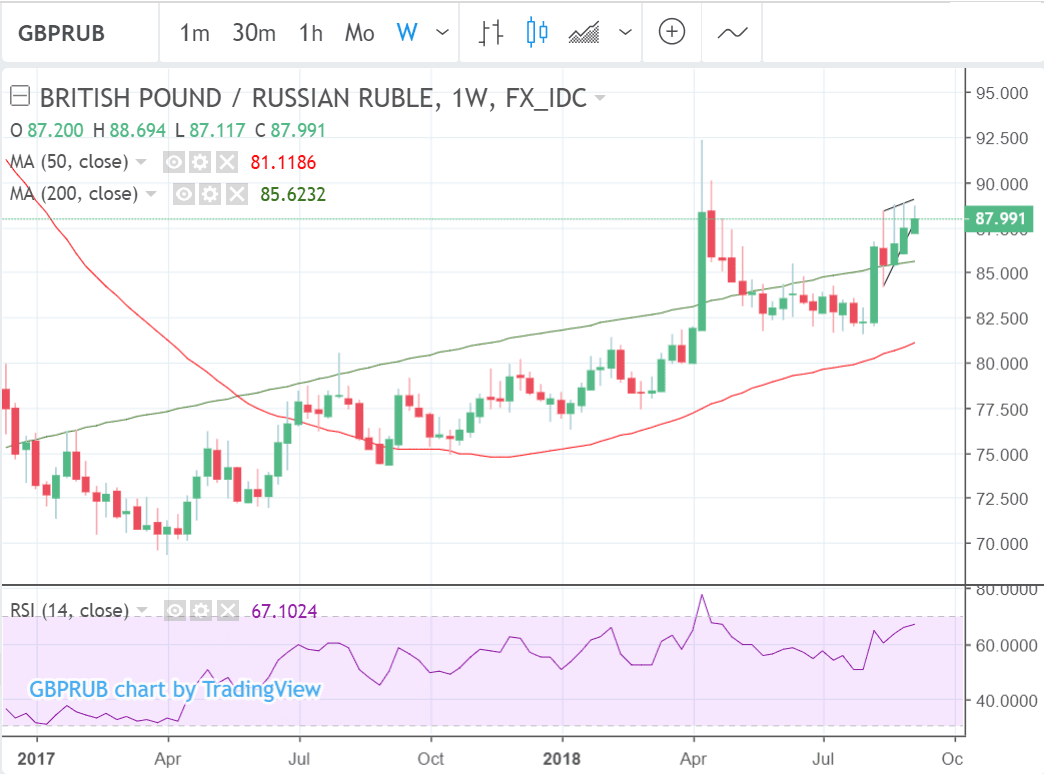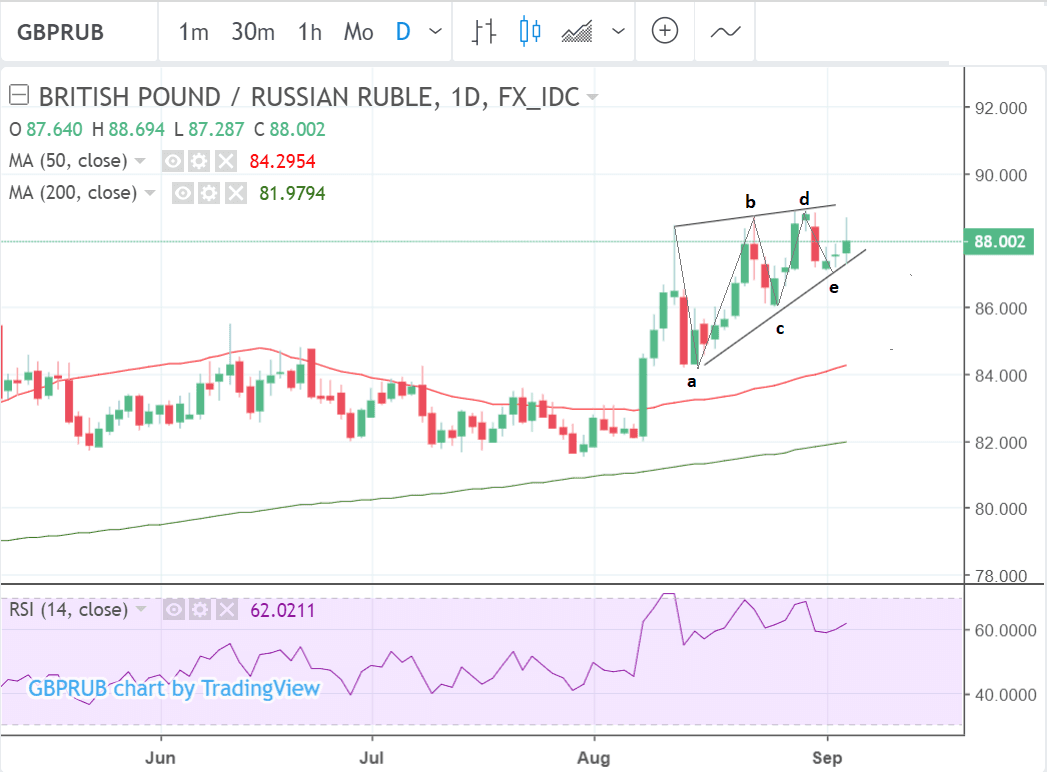Russia's Ruble at Risk of Break Lower Against Sterling and the Dollar

Image © Adobe Stock
- RUB prone to threat of more sanctions following Salisbury poisoning developments
- Chart patterns warn of volatility on the horizon
- Central Bank of Russia hints at taking measures to support RUB
The Russian Ruble is consolidating against both the Pound and the US Dollar despite a worsening diplomatic outlook which could see hotter moves on the horizon.
USD/RUB and GBP/RUB are forming chart patterns which indicate the potential for a volatile breakout commensurate with relations worsening between the UK and Russia which could ultimately further isolate the country.
Mid-week saw UK police charge two Russians with the poisoning by Novichok of former KGB agent Sergie Skripal and his daughter Yulia in Salisbury earlier this year.
It was later reported that Prime Minister Theresa May had called a meeting of the UN security council based on the police evidence incriminating the two men.
"Brace for greater Ruble volatility," says Thu Lan Nguyen, an analyst with Commerzbank in Frankfurt. "the developments could prove significant from the point of view of triggering additional sanctions."
The Russian authorities have always denied involvement in the poisoning but May said the new evidence casts doubt on that assertion and suggests the long hand of the Russian state is at play.
It could lead to the imposition of further sanctions against Russia which would probably hurt the Ruble.
"The findings have the potential to trigger additional sanctions because the US has anyway imposed a first round of sanctions for this act, and warned that the second round would be far more draconian. Russia could avoid this second round by opening itself up to foreign investigations and meeting a list of demands – but no one really expects Russia to oblige in this specific way," says Nguyen.
Where Next for the Ruble?
From a technical perspective the USD/RUB chart shows the pair has formed a triangle pattern in the midst of an uptrend.
The triangle, which is probably a continuation pattern, looks complete after forming the minimum five component waves (a-e) and it could be primed for a breakout.
A move above the b-wave highs at 69.02 could confirm a bullish breakout to a target at 70.98.
Alternatively, a move below the e-wave lows at 67.32 would confirm a bearish breakout to a target at 65.20.
The fundamentals point to increased sanctions against Russia weakening the Ruble and therefore favour a breakout higher rather than lower.
The Pound-Ruble pair is in a medium-term uptrend which is biased to continue rising.
The daily chart shows GBP/RUB has consolidated in a pattern too, although it is not yet clear whether it is a rising wedge or a right-angled triangle.
If it it is right-angled triangle it has bullish connotations for the pair in line with expectations of Ruble weakness on the back of the Skripal affair.
A break above the 90.00 level would provide confirmation of a move higher, with a conservative upside target at 91.00 initially and then 92.00.
If the pattern is a rising wedge, however, it will probably breakout lower, with a sell-off below the 87.00 level probably leading to a sell-off down to 86.00 initially, followed by 85.00. Momentum is subdued an slightly bearish.
Overall we see risks of a move higher as marginally greater than lower based on the longer-term uptrend and the fundamental outlook.
The bullish outlook for the pair is not clear-cut, however, amidst talk of the Russian central bank taking action to stem the sell-off in the Ruble.
"Russia’s central bank is setting the stage for an increase in interest rates as a weakening ruble fans inflation," says Andria Andrianova in an article for Bloomberg News, published on September 4.
Raising interest rates is a typical method used by central banks to support their currency as it attracts greater inflows of foreign capital drawn by the higher returns on offer, as well as limiting outflows due to the better risk premium on offer.
Inflation in Russia rose to 3.1% in August as the weak Ruble increases the price of foreign goods.
The possibility of even more weakness due to sanctions or further EM stress is another risk factor.
Regardless of the result of the latest twist in the Skripal affair the US is preparing to widen its existing sanctions on Russia in 90 days time, according to a Patrick Wintour, diplomatic editor of the Guardian.
"The second batch of sanctions related to the poisoning case will be imposed after 90 days if Russia does not allow inspectors from the Organisation for the Prohibition of Chemical Weapons (OPCW) to confirm that it no longer has chemical weapons," says Wintour.
The big question for investors will probably now be how much the Russian central bank is willing to do to defend its currency, with the next meeting, scheduled for September 14 now live.
"Bank of Russia Governor Elvira Nabiullina said Tuesday that there were factors in favor of raising rates at a meeting next week, even though most evidence still pointed toward leaving borrowing costs unchanged. For now, all 14 economists polled by Bloomberg predict the benchmark will be kept at 7.25 percent on Sept. 14. Still, a discussion over more drastic measures may be heating up," says Bloomberg's Anna Andrianova.
Advertisement
Get up to 5% more foreign exchange for international payments by using a specialist provider to get closer to the real market rate and avoid the gaping spreads charged by your bank when providing currency. Learn more here







